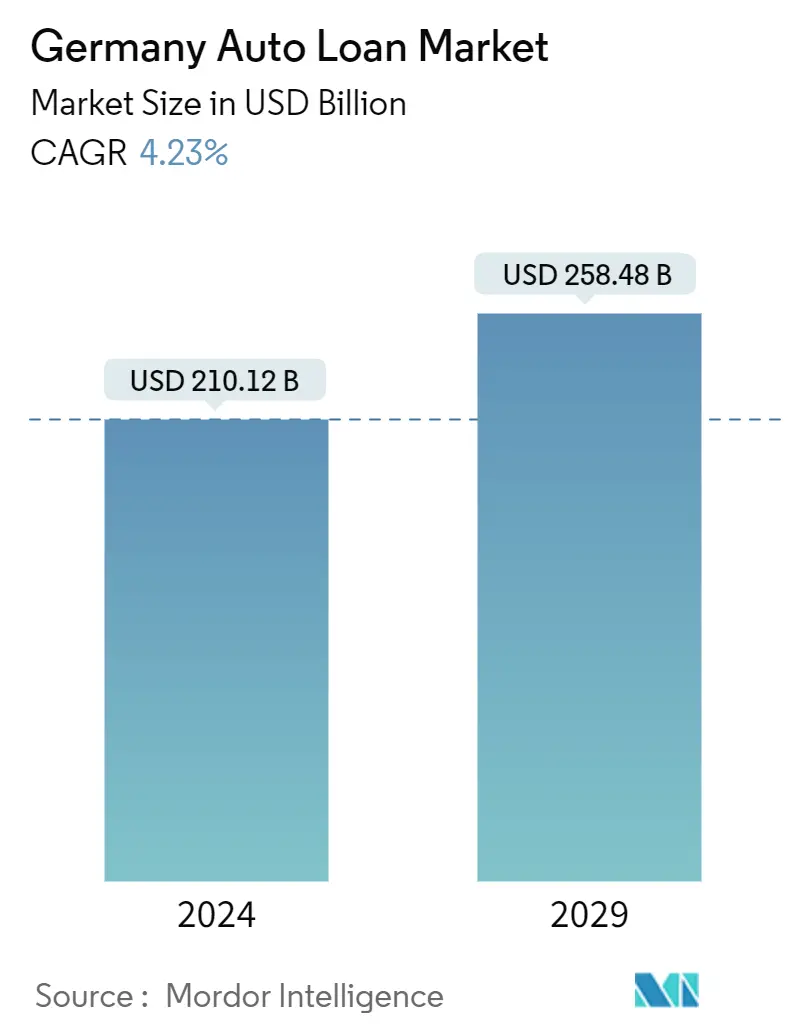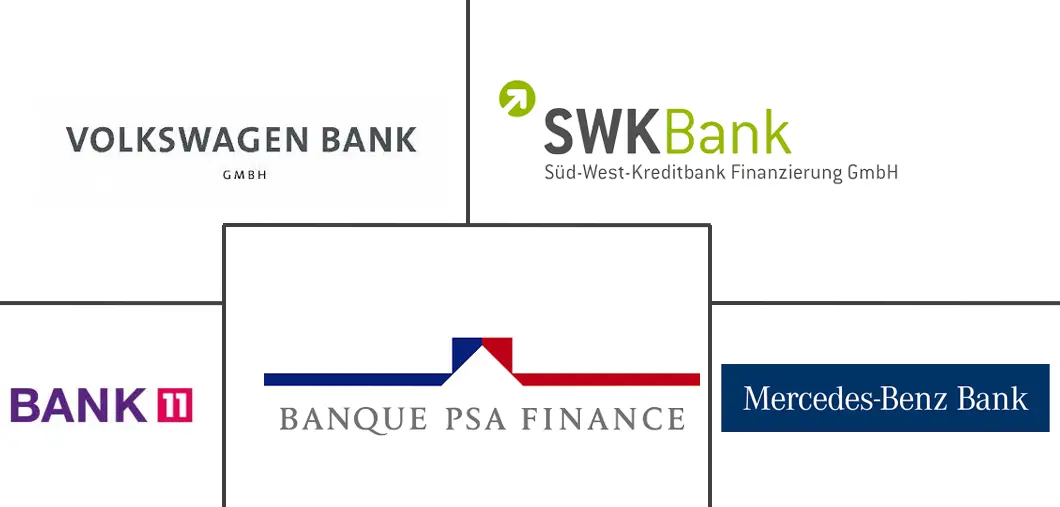Market Size of Germany Auto Loan Industry

| Study Period | 2020-2029 |
| Base Year For Estimation | 2023 |
| Market Size (2024) | USD 210.12 Billion |
| Market Size (2029) | USD 258.48 Billion |
| CAGR (2024 - 2029) | 4.23 % |
| Market Concentration | Medium |
Major Players
*Disclaimer: Major Players sorted in no particular order |
Germany Auto Loan Market Analysis
The Germany Auto Loan Market size is estimated at USD 210.12 billion in 2024, and is expected to reach USD 258.48 billion by 2029, growing at a CAGR of 4.23% during the forecast period (2024-2029).
Germany is recognized the world over for its outstanding automotive industry and excellence in engineering. A popular financing option in Germany is the "Ballonfinanzierung," which involves lower monthly payments with a larger final payment (balloon payment) at the end of the term. Leasing is a common alternative to purchasing in Germany. Both individuals and businesses often opt for leasing arrangements, providing flexibility and potential tax benefits. Germany's strong economic stability contributes to a robust automobile finance market, with consumers having the confidence and means to finance vehicle purchases.
The industry has embraced digitalization, and many lenders offer online platforms for convenient loan applications, approvals, and management. The presence of renowned automotive manufacturers in Germany contributes to a thriving automobile finance sector. Affiliation with these brands may influence financing options.
Germany's robust economic stability contributes to a strong auto loan market. Government incentives, particularly for electric vehicles, can impact consumer choices and influence financing options. Incentives may include tax benefits and subsidies. Traditional banks, credit unions, and specialized auto finance companies contribute to a diverse landscape of lenders offering auto loans. Interest rates on auto loans in Germany are competitive and influenced by factors such as the borrower's creditworthiness, loan terms, and prevailing economic conditions.
Germany Auto Loan Industry Segmentation
An auto loan is a segment of the loan category offered by banks and financial service providers to automobile buyers over a given period with an agreed interest rate and installment amount. Mostly, the loan is taken for two segments of automobiles, which consist of passenger and commercial vehicles.
The study gives a brief description of the German auto loan market and includes details on interest rates, type of loans offered, and auto loan products & services. Germany's auto loan market is segmented by product, ownership, provider type, and tenure. By Product, the market is segmented into passenger vehicles and commercial vehicles. By ownership, the market is segmented by new vehicles and used vehicles. By provider type, the market is segmented by banks, nonbanking financial companies, original equipment manufacturers, credit unions, and others. Others include fintech companies. By tenure, the market is segmented into less than three years, 3-5 years, and more than 5 years.
The report offers market size and forecasts for the German auto loan market in value (USD) for all the above segments.
| By Vehicle Type | |
| Passenger Vehicle | |
| Commercial Vehicle |
| By Ownership | |
| New Vehicles | |
| Used Vehicles |
| By Provider Type | |
| Banks | |
| Non Banking Financials Companies | |
| Original Equiptment Manufacturers | |
| Credit Unions | |
| Other Provider Types |
| By Tenure | |
| Less than Three Years | |
| 3-5 Years | |
| More Than 5 Years |
Germany Auto Loan Market Size Summary
The Germany auto loan market is poised for steady growth, driven by the country's strong automotive industry and economic stability. The market is characterized by popular financing options such as "Ballonfinanzierung," which offers lower monthly payments with a larger final payment, and leasing arrangements that provide flexibility and potential tax benefits. The digitalization of the industry has led to the emergence of online platforms for loan applications and management, enhancing convenience for consumers. The presence of renowned automotive manufacturers in Germany further bolsters the automobile finance sector, with government incentives for electric vehicles influencing consumer choices and financing options. A diverse landscape of lenders, including traditional banks, credit unions, and specialized auto finance companies, contributes to the competitive nature of the market, with interest rates influenced by factors such as creditworthiness and economic conditions.
The new vehicle sales segment is a significant driver of the auto loan market, with consumers often seeking financing options for their purchases. This demand for new vehicles impacts loan volumes and lender profitability, as new vehicle loans typically have higher principal amounts. The shift towards electric vehicles is also shaping the market, with consumers seeking tailored financing options to accommodate the higher upfront costs and potential incentives. The fragmented market sees key players like Volkswagen Bank GmbH, Mercedes-Benz Bank AG, and others striving to offer competitive interest rates and enhance customer service to differentiate themselves. Recent developments, such as Europcar Mobility Group's acquisition of a controlling stake in Euromobil GmbH, highlight the ongoing evolution and collaboration within the industry, supporting further growth and innovation in the German auto loan market.
Germany Auto Loan Market Size - Table of Contents
-
1. MARKET DYNAMICS AND INSIGHTS
-
1.1 Market Overview
-
1.2 Market Drivers
-
1.2.1 Leading Share of Passenger Vehicle Sales
-
1.2.2 Quick Processing of Loan through Digital Banking
-
-
1.3 Market Restraints
-
1.3.1 Rising Interest Rates Affecting New Auto Buyers Demand for Loan
-
-
1.4 Market Opportunities
-
1.4.1 Emerging Market of Electric Vehicles Expanding the Auto Loan Market
-
-
1.5 Industry Attractiveness - Porter's Five Forces Analysis
-
1.5.1 Bargaining Power of Suppliers
-
1.5.2 Bargaining Power of Buyers
-
1.5.3 Threat of New Entrants
-
1.5.4 Threat of Substitutes
-
1.5.5 Intensity of Competitive Rivalry
-
-
1.6 Insights on Consumer Behavior Analysis
-
1.7 Insight on Various Government Regulations in the Market
-
1.8 Insights on Technological Innovations in Auto Loan Market
-
1.9 Impact of COVID-19 on the Market
-
-
2. MARKET SEGMENTATION
-
2.1 By Vehicle Type
-
2.1.1 Passenger Vehicle
-
2.1.2 Commercial Vehicle
-
-
2.2 By Ownership
-
2.2.1 New Vehicles
-
2.2.2 Used Vehicles
-
-
2.3 By Provider Type
-
2.3.1 Banks
-
2.3.2 Non Banking Financials Companies
-
2.3.3 Original Equiptment Manufacturers
-
2.3.4 Credit Unions
-
2.3.5 Other Provider Types
-
-
2.4 By Tenure
-
2.4.1 Less than Three Years
-
2.4.2 3-5 Years
-
2.4.3 More Than 5 Years
-
-
Germany Auto Loan Market Size FAQs
How big is the Germany Auto Loan Market?
The Germany Auto Loan Market size is expected to reach USD 210.12 billion in 2024 and grow at a CAGR of 4.23% to reach USD 258.48 billion by 2029.
What is the current Germany Auto Loan Market size?
In 2024, the Germany Auto Loan Market size is expected to reach USD 210.12 billion.

